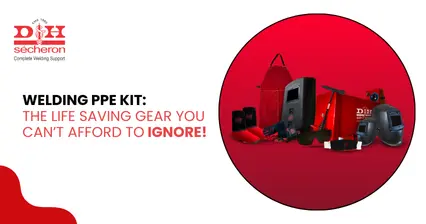Ways of Using Stainless Steel Rods: Pros and Cons
Stainless steel is a popular choice in various industries for its exceptional properties, including corrosion resistance, durability, and aesthetic appeal. When it comes to welding stainless steel, using the right welding rods is crucial to achieve strong and long-lasting welds.
Let’s get to know the different ways of using stainless steel electrodes, along with their pros and cons.
Advantages of Stainless-Steel Welding
- Corrosion Resistance: Stainless-steel welding is exceptionally resistant to corrosion because of the chromium it contains which forms a protective oxide layer on the surface when exposed to oxygen. This oxide layer acts as a barrier, preventing rust and corrosion, making it suitable for applications in harsh environments.
- Durability and Strength: Known for its high strength and durability, it’s preferred for applications that require structural integrity and longevity. When properly welded, stainless steel joints exhibit excellent mechanical properties, including toughness and fatigue resistance.
- Aesthetic Appeal: Stainless steel provide a sleek and polished finish, making it ideal for applications where visual appeal is essential such as architectural structures, kitchen appliances, etc.
- Wide Range of Applications: Because of its versatility, it is used in a wide range of applications and industries like construction, automotive, food processing, pharmaceuticals, etc.
Disadvantages of Stainless-Steel Welding
- Cost: Stainless-Steel welding is more expensive primarily because of the higher price of the metal itself, as well as the specialized equipment and techniques required for stainless steel welding.
- Heat Sensitivity: Because of its lower thermal conductivity, it retains heat more efficiently which makes it prone to distortion and warping. Proper heat management and welding techniques are essential to mitigate these issues.
- Specialized Equipment and Expertise: Welding stainless steel requires the use of appropriate shielding gases, filler metals, and welding techniques for achieving high-quality welds along with skilled welders with expertise in stainless steel welding are crucial for optimal results.
Ways of Using Stainless Steel Rods
- Shielded Metal Arc Welding (SMAW): Also known as stick welding, SMAW is a popular method suitable for both indoor and outdoor applications. It involves using a consumable electrode coated with flux to create an arc between the electrode and the base metal.
- Gas Tungsten Arc Welding (GTAW): Commonly known as TIG welding, GATW uses a non-consumable tungsten electrode and an inert shielding gas to protect the weld from atmospheric contamination. GTAW provides precise control and produces high-quality welds, making it suitable for intricate and critical applications.
- Metal Inert Gas Welding (MIG): MIG welding is a semi-automatic process that utilizes a continuously fed wire electrode and an inert shielding gas. It offers high productivity and is suitable for thicker stainless-steel sections. MIG welding is commonly used in industries such as automotive, fabrication, and manufacturing.
Welding stainless steel using the appropriate stainless-steel rods offers numerous advantages, including corrosion resistance, durability, and aesthetic appeal. However, it is essential to be aware of the potential disadvantages and employ the right welding materials to ensure successful outcomes. At D&H Secheron, we provide high-quality stainless steel welding rods that are designed to deliver reliable and efficient welds. Explore our range of stainless steel welding rods to enhance your metal welding projects.
11 May 2025 | Welding
An In-Depth Exploration of Low-Alloy Steel: Your Comprehensive Guide
11 May 2025 | Welding
Nagpur - Bori - Tuljapur Road MSH-3 in Yavatmal District (Maharashtra)
11 May 2025 | Welding
Guidelines to Understand Gas Welding: Applications, Advantages & Disadvantages
11 May 2025 | Welding
3 Tips for Finding the Best Mild Steel Electrode for Your Application
11 May 2025 | Welding
How to Select the Right Welding Filler Wires for Stainless Steel Welding?
11 May 2025 | Welding
Building the Narendra Modi Stadium with Norma V and Autotherme-1 Electrodes
11 May 2025 | Welding
Low Alloy Steel Welding in a (PEB) Pre Engineered Building Structure
11 May 2025 | Welding
Welding Rods: Different Types and Tips for Properly Storing and Handling
11 May 2025 | Welding
Tips for Flawless Welds with Stainless Steel Electrodes: Pros and Cons
11 May 2025 | Welding
Exploring Applications and Benefits of Stainless Steel Welding Electrodes
11 May 2025 | Welding
Welding Basics: Joining Metals with Heat and Pressure - A Beginners Guide
11 May 2025 | Welding
Distinguishing Low-Alloy Steel from High-Alloy Steel: Understanding the Variations
11 May 2025 | Welding
Hard Facing Wire - Understanding the Process and Achieving Optimal Result
11 May 2025 | Welding
Exploring the Advantages of Stainless Steel Electrodes in Welding Applications
11 May 2025 | Welding
Weathering Steel vs. Traditional Steel: A Comparative Analysis of Performance
11 May 2025 | Welding
Choosing the Right Welding Rod: Why 6013 Electrodes Might Be Your Ideal Option
11 May 2025 | Welding
Why 7018 Electrodes Are Preferred for High-Strength Welds in Pipeline Construction
11 May 2025 | Welding
Filler Wire vs. Stainless Steel Filler Wire: Understanding the Key Differences
11 May 2025 | Welding
Exploring the Impact of Filler Material on Welding Quality and Durability
11 May 2025 | Welding
Choosing the Right Cast Iron Electrode for Different Welding Projects
11 May 2025 | Welding
Top Advantages of Cast Iron Electrodes for Industrial Welding Applications
11 May 2025 | Welding
Key Benefits and Challenges of Using TIG Welding in Industrial Projects
11 May 2025 | Welding
5 Reasons Why 7018 Electrode is the Gold Standard for Welding Professionals
11 May 2025 | Welding
Top 5 Advantages of Flux Cored Arc Welding for Heavy-Duty Applications.png)
11 May 2025 | Welding
Lotherme-601: A Game-Changer for Restoring Shoulder Pins in Heavy Machinery
11 May 2025 | Welding
How D&H Sécheron Helped Repair a Rotary Kiln’s Cooler Section with LoTherme 352
11 May 2025 | Welding
Piston Repair for Mining Industry: Cost-Effective Solutions with LoTherme 468.webp)






.jpg)







































.jpg)
.jpg)

.jpg)

.jpg)





.jpg)
.jpg)
.jpg)



.webp)
.jpg)
.jpg)
.webp)
.jpg)






















.png)



.webp)

.webp)
.webp)



